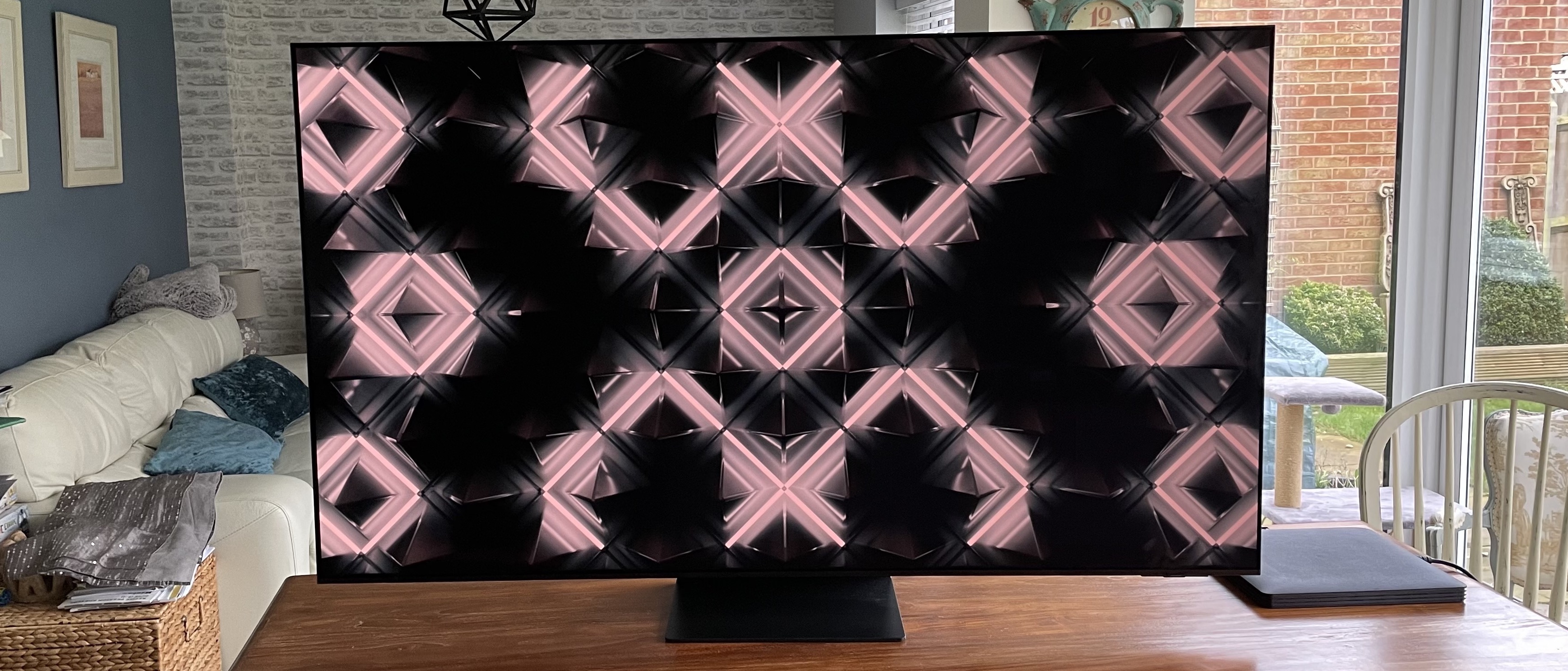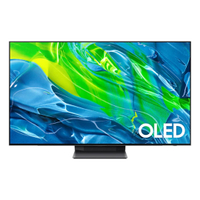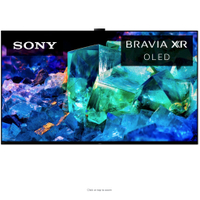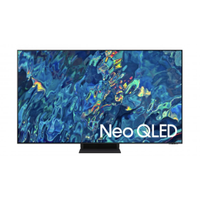TechRadar Verdict
Samsung’s second generation of Quantum Dot OLED TV provides strong proof that we were right to predict great things for this new technology. The S95C is more spectacular but also more controlled than its already illustrious predecessor - and we can’t get enough of it.
Pros
- +
Wonderfully bright, colourful pictures
- +
Spectacular contrast
- +
Excellent gaming support
Cons
- -
No Dolby Vision support
- -
Some initial presets need work
- -
Slightly aggressive tone mapping
Why you can trust TechRadar
Editor's Note
• Original review date: April 2023
• Samsung S95D due for release spring 2024
• Launch price: From $2,499 / £2,399 / AU$3,999 (55-inch)
• Target price: From $1,699 / £1,499 (55-inch)
Update: February 2024. Offering the total QD-OLED experience, the Samsung S95C is still the definition of a premium TV. It has an outstanding picture with deep black levels combined with higher fullscreen brightness than any of the best OLED TVs today, and is perfect for gamers. With the Samsung S95D due in spring 2024, which promises extra anti-reflection tech as well as a 20% boost in brightness, the S95C is sure to get some more price drops. We’ve seen the 55-inch S95C for as low as $1,499 / £1,449 before, but if you end up paying our target price above, you’ll still be getting a good deal. The rest of this review remains as previously published.

Samsung S95C OLED TV: Two-minute review
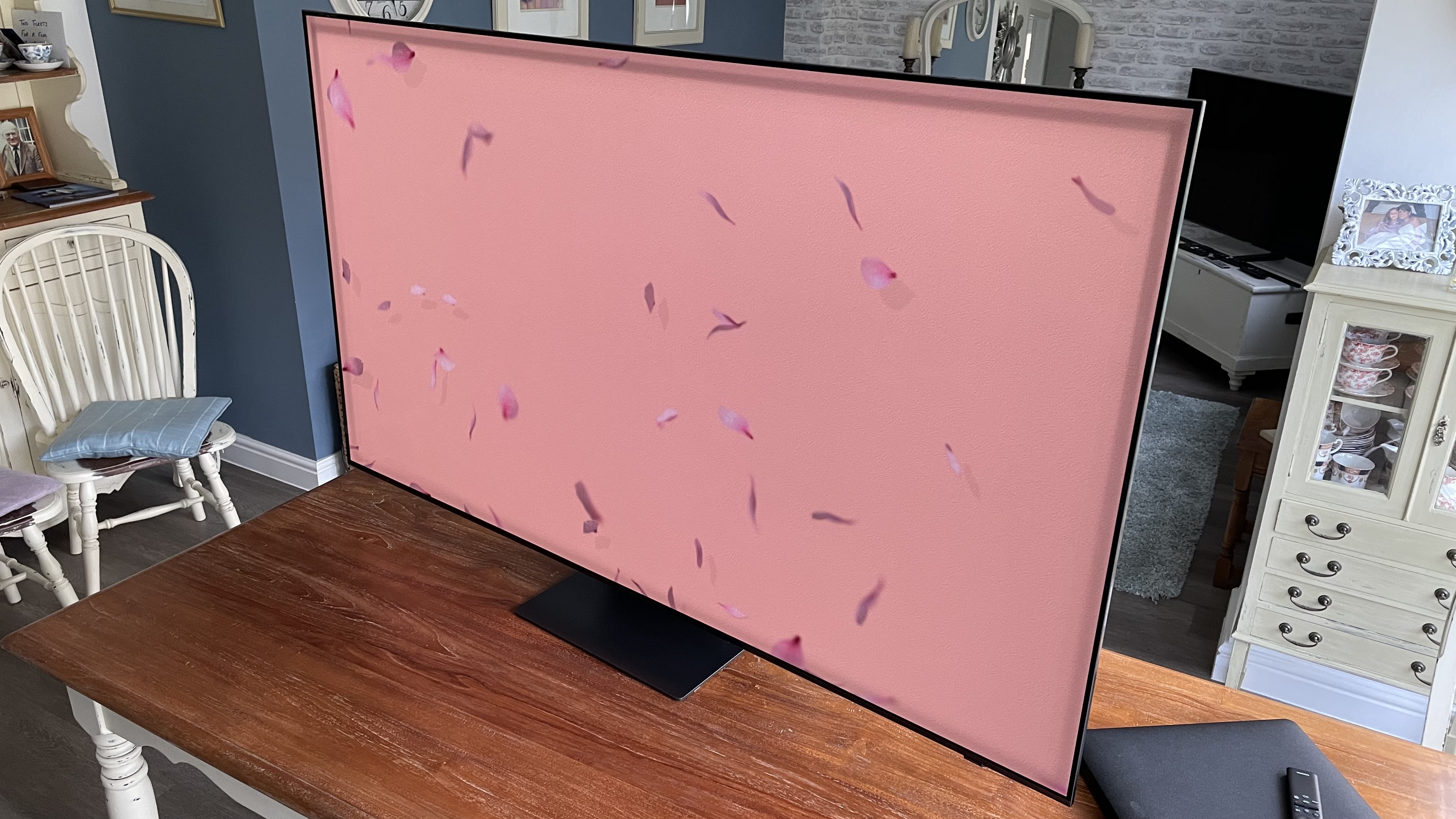
After more than a decade telling us not to buy OLED TVs, in 2022 Samsung released… an OLED TV. Or, at any rate, its own new spin on OLED technology, powered by Quantum Dots. The S95B TVs were pretty remarkable given their tech debut status - but the new S95Cs outgun them in almost every department.
Especially brightness. Samsung has managed to find almost 40% more brightness than it delivered with last year’s S95B QD-OLED models. A brightness increase of this magnitude would be significant with any TV, but it’s truly transformational when applied to a self-emissive, every-pixel-makes-its-own-light technology like OLED.
The extra brightness is particularly effective in taking high dynamic range video to a whole new level of enjoyment, drama and realism, but also feeds gloriously into the S95C’s colours, unlocking levels of colour volume and purity, even in bright colour areas, we’ve never seen before on an OLED TV. This reminds us of QD OLED’s biggest selling point: the way it creates its colours using purely red, green and blue elements, without the extra white element used by traditional OLED TVs.
Sharpness, upscaling and viewing angles are all superb too, and even the S95C’s sound quality is a big step up from that of its predecessor.
The Samsung S95C faces some seriously stiff competition this year from the best 4K TVs, but it delivers more than enough of a leap over its already impressive predecessor to mean that it will surely be right in the mix with the best OLED TVs when awards season comes round.
Samsung S95C OLED TV review: price and release date
- Release date: March 2023
- 55-inch: £2,399 / $2,499 / AU$3,999
- 65-inch: £3,599 / $3,299 / AU$4,999
- 77-inch: £5,099 / $4,499 / AU$7,999
As it did in 2022, Samsung has decided to pitch the 65-inch S95C slightly below its flagship 4K Neo QLED mini-LED TV. Only £100/$100 below, but that’s still enough of a gap to make a statement about where Samsung believes its ultimate picture technology lies. I’m pretty convinced that many AV enthusiasts won’t agree with Samsung on this, but hey - if it means we get the S95C for a little less than we would if it was positioned as the flagship model, who are we to complain?
The S95C is Samsung’s premium QD-OLED offering for 2023, though. Unlike 2022, Samsung is this year introducing two QD-OLED TV tiers, with the cheaper S90Cs delivering a more subdued performance increase over the S95Bs but costing a hefty £600 less.
The 65-inch S95C is joined by a new 77-inch sibling, as well as a more expected 55-inch option. These cost £5,099 / $4,499 and £2,399 / $2,499 respectively.
Samsung S95C OLED TV review: Specs
| Screen type: | Quantum Dot OLED |
| Refresh rate: | 120Hz |
| HDR support: | HDR10, HDR10+, HLG |
| Audio support: | Dolby Atmos, DTS |
| Smart TV: | Tizen |
| HDMI ports: | 4 HDMI 2.1 |
| Built-in tuner: | ATSC 3.0 |
SAMSUNG S95C OLED TV review: Benchmark results
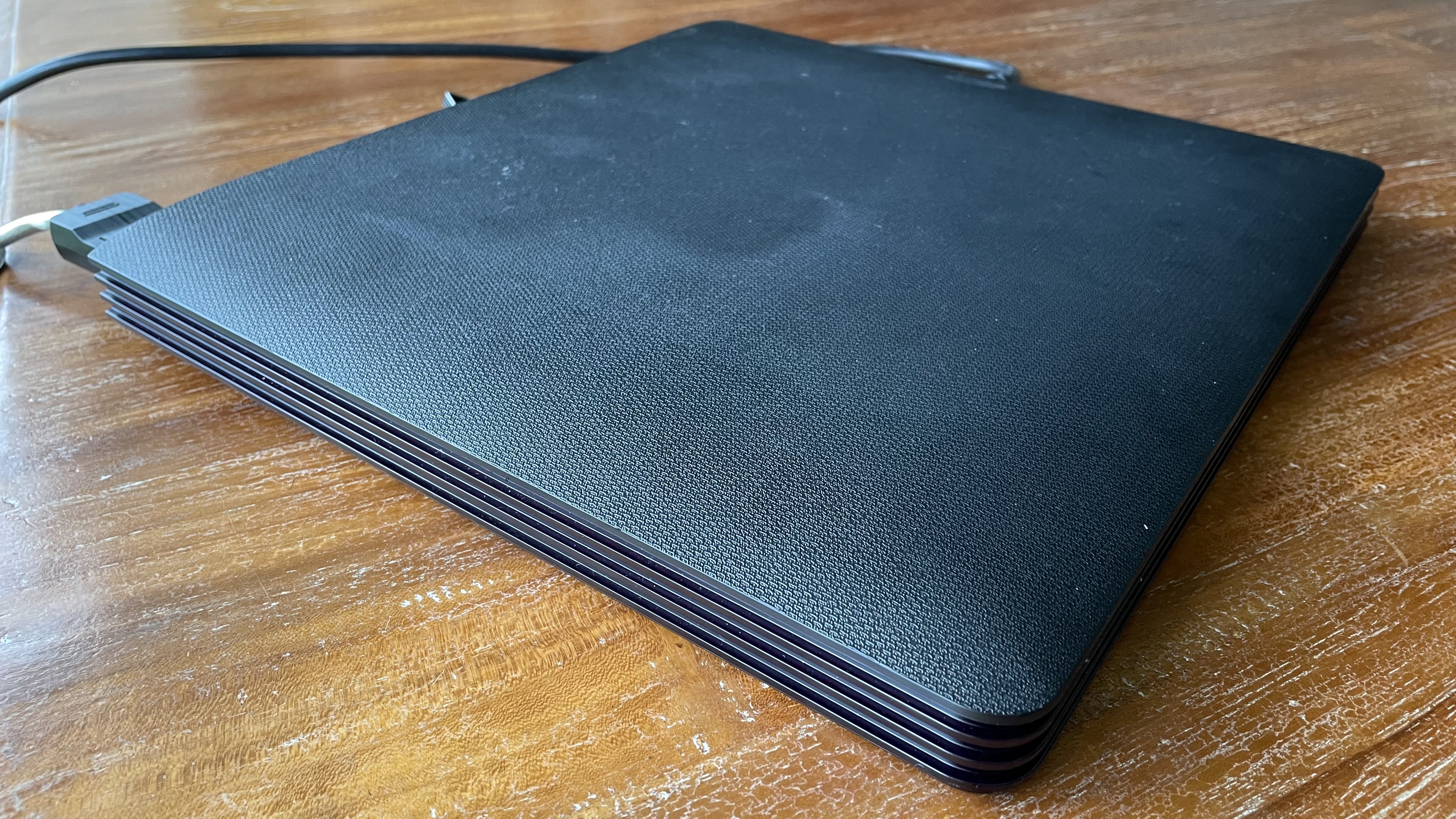
Samsung S95C OLED TV review: features
- Second-gen Quantum Dot OLED panel
- Native 4K resolution with HDR support
- AI processing drawn from 20 Neural networks
By far the most eye-catching feature of the S95C is that it introduces us to the second generation of Samsung’s Quantum Dot OLED panel. The highlight of which is the 40% or so extra brightness it achieves. This is down to a combination of tweaks to the organic materials it uses, switching to more efficient deuterium, and introducing an OLED brightness booster designed to optimise (down to pixel level) an image’s brightest and darkest parts.
The improvements that deliver this key new level of brightness do so without needing significantly more power, too, meaning the S95C doesn’t have to worry about falling foul of the EU’s heavy handed new power consumption regulations.
The S95C’s new-found brightness feeds into the same pure red, green and blue colour system that distinguishes Samsung’s OLED take from the traditional, so-called WOLED take. So we’d hope to be seeing even more richly saturated colours than we got from the S95B.
Since QD-OLED is, like WOLED, a self-emissive technology, each and every pixel in the S95C’s pictures can produce its own light and colour, hopefully resulting in levels of local contrast that you just can’t get on even the best LCD TVs. The panels’ self-emissive nature also means you can watch the S95C from wide viewing angles without the picture losing colour or contrast (unlike the vast majority of LCD TVs).
Samsung has upgraded its processor this year, drawing on the accumulated know-how of no less than 20 individual neural networks, to deliver a number of further benefits beyond the previously mentioned brightness booster. Perceptual colour mapping, for instance, is designed to express colours so that they more closely resemble the sort of tones the human eye sees in the real world. There’s enhanced object detection processing, too, to help the picture look more like your eyes perceive depth and focus in the real world.
The new enhanced AI elements of the S95C’s ‘Neural Quantum 4K’ processor are also promised to feed into an improved 4K upscaling process for HD and SD content.
The S95C’s 4K resolution is backed up by support for the HDR10, HLG and HDR10+ HDR formats. This is fine so far as it goes, but Samsung’s continuing refusal to also onboard the popular Dolby Vision HDR format still frustrates. Especially given how widespread content mastered in Dolby’s premium HDR format is.
Samsung provides a small but fairly diverse range of picture presets, as well as numerous tools for adjusting pretty much every aspect of the TV’s processing and core picture balances and settings. You can also calibrate the picture yourself to a startlingly accurate level using just the TV’s Smart Calibration system in conjunction with your mobile phone.
We’ll cover the S95C’s impressive gaming support and less impressive smart TV interface later. One last thing definitely worth covering here, though, is the S95C’s promising audio set up. For starters it deploys a 4.2.2 configuration of real (rather than virtual) speaker channels that combines eight substantial mid/bass drivers spread right across the TV’s rear with smaller detail speakers ranged around the TV’s edges. It then feeds a promising 70W of power into these speakers, and applies the latest version of Samsung’s Object Tracking Sound+ system to make specific sound effects appear to be coming from the correct place on the screen. Or maybe also the correct place just off the screen.
You can always add one of the best Dolby Atmos soundbars if you want to step the sound accompanying the S95C up a few gears. As with all of Samsung’s premium TVs in recent years you can connect the S95C to a Samsung soundbar through its Q Symphony system, where the TV’s speakers join forces intelligently with those of the soundbar to create a bigger and more detailed soundstage. You can even wirelessly transmit (lossy) Dolby Atmos from the TV to a compatible Samsung soundbar.
- Features Score: 5/5
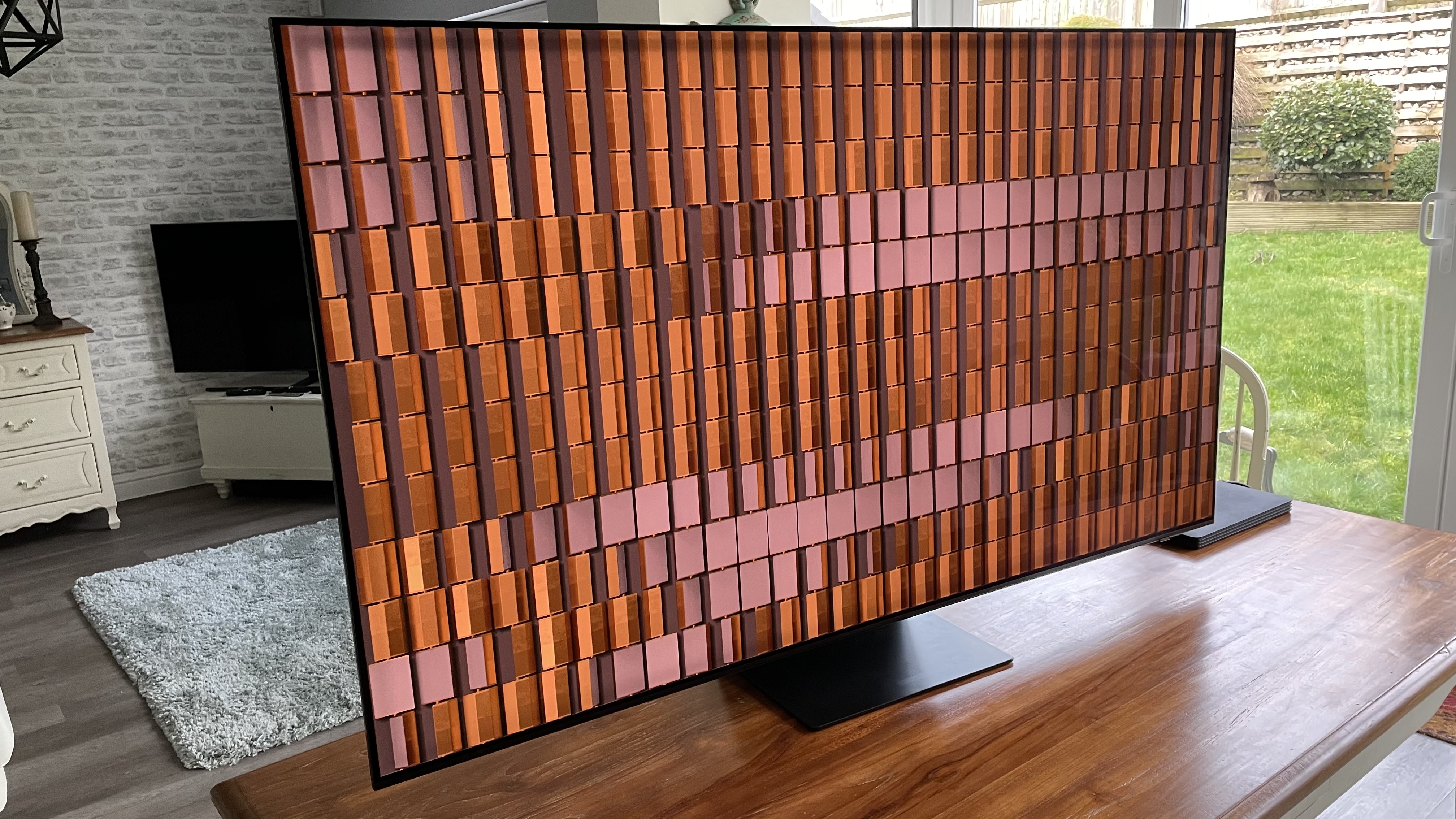
Samsung S95C OLED TV review: picture quality
- Stunning brightness for OLED technology
- Beautifully pure, vibrant colours
- Stunning contrast and black levels
Good though the S95B was, the S95C is so much better that it almost makes its predecessor feel like a trial run.
The first thing that hits you is how much brighter it is. We’re not just talking about the usual sort of incremental, few nits here, few nits there brightness increase we’re used to seeing with OLED technologies, either. I measured peak brightness to be as much as 1,400 nits on a white HDR window covering 10% of a black screen, compared with a maximum figure of around 1,040 nits on 2022’s S95B. That’s a huge increase that genuinely transforms the viewing experience.
High dynamic range content, for instance, looks vastly more punchy and realistic - especially as the intensity with which bright highlights like shots of the sun, bright lamps, light glinting off metal and glass and so on is delivered without any compromise to the sort of deep, rich, inky black colours that are the foundation of OLED’s traditional home cinema talents.
In fact, the S95C has greatly improved on its predecessor where black level consistency is called, thanks to a new filter that reduces the potential for ambient light to introduce greyness into dark scenes.
The S95C even manages to deliver a significant uptick in the luminance of HDR images that flood the whole screen with brightness (a type of content which OLED always struggles to handle). A full 100% white HDR window is displayed at around 265 nits - up from 200 or less nits with previous OLED panels. Again, this represents a major rather than incremental increase that makes the HDR viewing experience feel much more consistently intense and ‘balanced’. The new luminance is pleasingly uniform right across the screen, too.
The S95C can’t sustain these sorts of full screen brightness levels - or, actually, its punchiest HDR peaks - for long before having to start dimming the image down. But actually with most video or gaming imagery, the image content changes regularly enough not to trigger the dimming to any really noticeable degree.
It’s worth adding that premium LCD TVs can achieve brightness levels of more than 500 nits - even beyond 800 nits in some cases - with full screen HDR content. But those TVs can’t put an image’s brightest pixel right alongside its darkest one without any compromise between the two like the S95C can.
Being able to deliver as much brightness as the S95C can through a pure RGB colour system (a blue emissive phosphor layer feeds its light through layers of red and green Quantum Dots) delivers a spectacularly rich, vibrant colourscape that holds up even in very bright parts of an HDR picture.
The vibrancy of the S95C’s colours doesn’t stop it from also delivering stellar levels of tonal subtlety and finesse, though, ensuring that not even the most exuberant tone looks flat or cartoonish. In fact, the S95C’s subtlety together with the sense of depth that comes from such precision represents one of its biggest advances over its QD OLED predecessor. The latest Neural Processor is clearly much cleverer than its 2022 iteration.
This improved processing can be seen, too, in how little noise the picture contains, even during grainy dark scenes, and in how well HD content is upscaled to the screen’s native 4K resolution. The processor’s ability to spot the difference between noise and real picture information when deciding what pixels to add to an HD or SD picture, even with low quality content, means it delivers results which can, at least with good quality HD sources, look very close to a native 4K picture experience.
As you might guess from the S95C’s sterling combination of colour finesse and noise management, its pictures look dazzlingly sharp and detailed. What’s more, this sharpness and detail is delivered, even using the TV’s most aggressive picture settings, without it being accompanied by stressed edges, exaggerated grain or other types of noise.
Almost the only area of the S95C’s pictures where the new processor hasn’t made any real progress is motion. The default Picture Clarity settings that host the TV’s motion controls generate distracting processing ‘glitches’ and cause 24p films to look unrealistically smooth.
Turning the motion processing off will probably be the preferred solution for many AV fans, though if you find judder too heavy with the motion processing off entirely, a Custom setting with blur and judder components set to level three or four provides a good compromise.
Other issues are few and far between, but they are there if you look really hard for them. Starting with the fact that while the S95C’s default Standard picture preset delivers the all-round most watchable and dynamic pictures, it can cause colours to look a touch desaturated in places. You can improve this, though, by toning down the dynamic tone mapping setting.
The Standard preset can also cause an occasional slight flicker to shots that contain subtle brightness shifts. This one isn’t easy to defeat, either - but it does only happen very rarely.
An untweaked Standard preset can also leave skin tones occasionally looking fractionally jaundiced - but in this case colour settings are provided that help you work around this.
The S95C can aggressively dim its pictures down if the screen starts to run very hot, but the sort of temperatures we’re talking about likely won’t crop up in typical living room conditions.
All I’ve really managed to show with this slightly desperate list of niggles, though, is that the S95C isn’t perfect. The fact remains - with knobs on - that the S95C’s pictures set dazzling new standards for the already high-performance OLED TV world.
- Picture quality score: 5/5
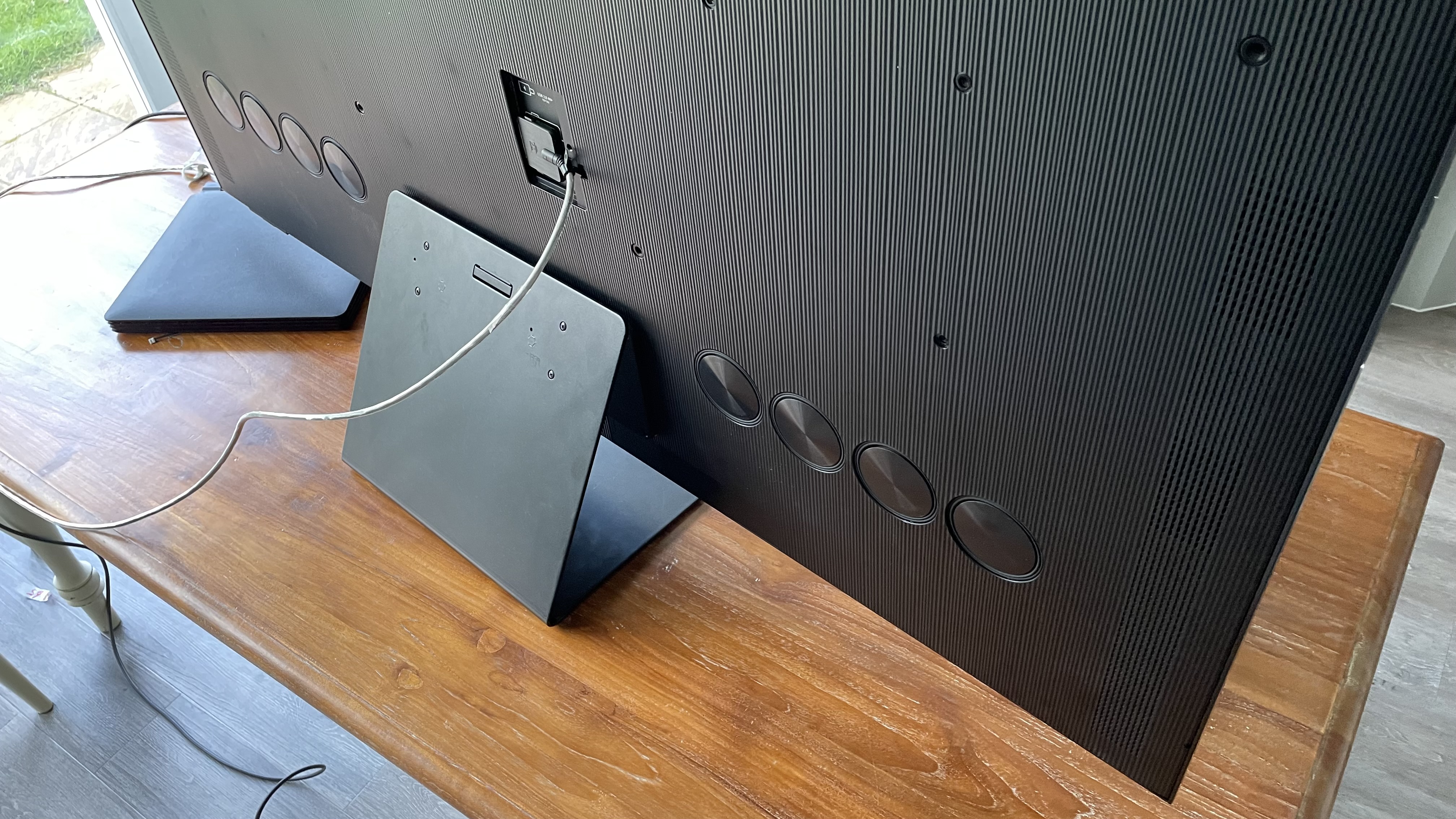
Samsung S95C OLED TV review: sound quality
- Object tracking sound system
- 70W of power
- Dolby Atmos decoding
The sound quality of last year’s S95B QD OLED debutante was pretty flakey - so it’s a relief to find the S95C sounding much, much better. Perhaps helped by its slightly meatier design, for instance, the new model manages to produce a much larger field of sound, pushing effects further away from the screen to the left, the right, and even slightly upwards.
The resulting wall of sound usually feels engaging and cinematic - especially since Samsung’s Object Tracking Sound system does a consistently excellent job of placing specific effects in a mix in the right place on the screen. Or just off the sides of the screen if that’s where a sound effect is supposed to be.
The OTS system plays pretty nicely with Dolby Atmos soundtracks, helping to deliver a credible sense of the busyness, dynamism and scale that Atmos is renowned for.
There’s enough power behind the sound to ensure both that the larger soundstage doesn’t feel fragile or incoherent, and that even quite faint details are reproduced with authority without becoming too ‘bright’.
The single biggest relief about the S95C’s sound, though, concerns its bass handling. The S95B struggled to deliver any sort of bass without its speakers starting to buzz and distort, but the S95C manages to go much deeper, and deliver its extra bass depths with more presence and weight and hardly any distortions. This instantly helps balance the audio out, so that trebles don’t sound too dominant, and gives action movie soundtracks more weight and credibility.
The sound doesn’t push out forward from the screen as much as I’d have liked it to, and although the sound is much more dynamic and full-blooded than that of its predecessor, it can still run out of steam before the film world’s loudest moments reach their crescendo, denying such moments some of their impact.
Overall, though, the S95C sounds good enough to at least make adding an external sound system something to think about doing at your leisure, rather than it being a pretty much instant necessity as it was with the S95B.
- Sound quality score: 4/5
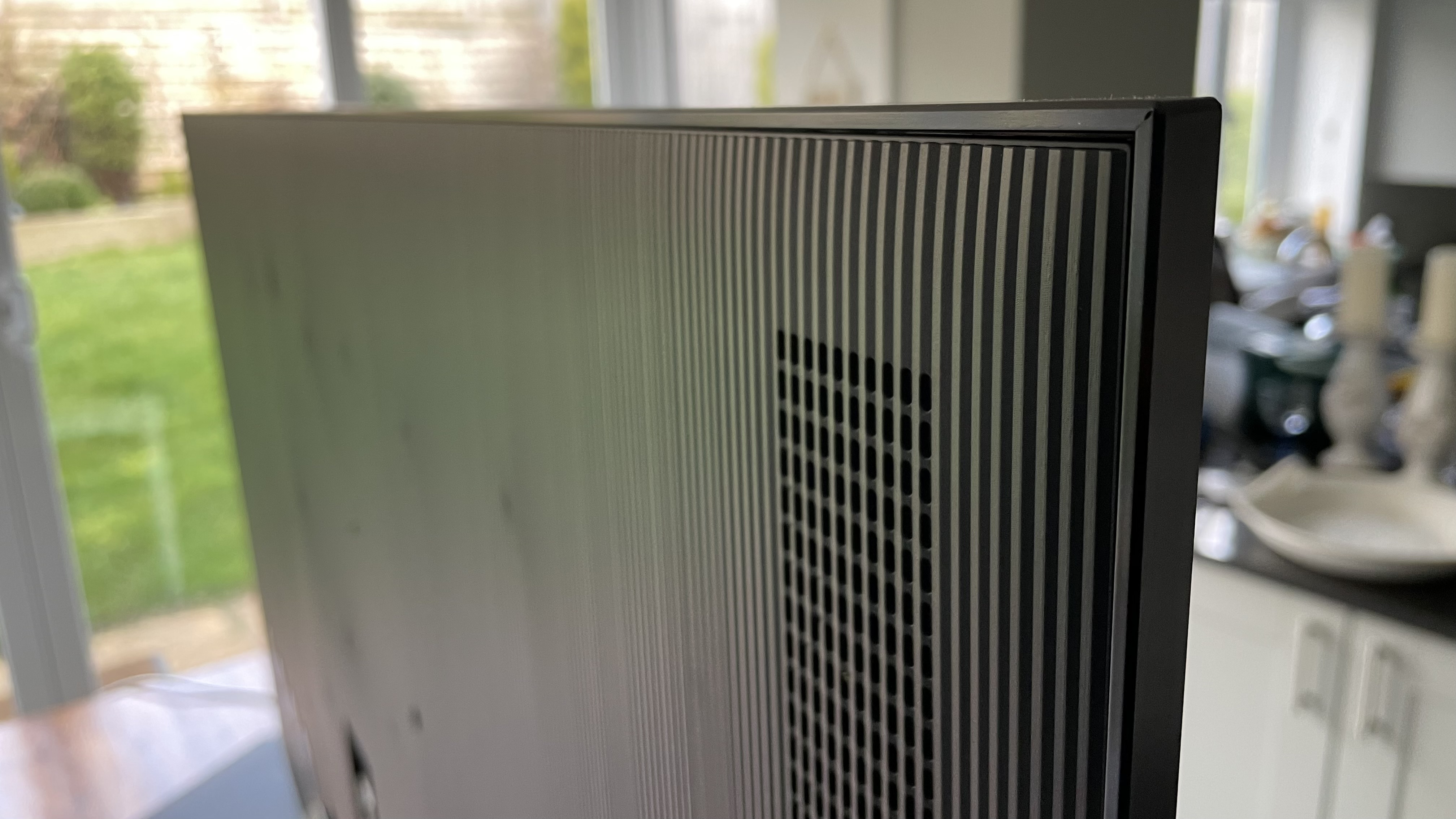
Samsung S95C OLED TV review: design
- Ships with a One Connect box
- So-called Infinity One design concept
- Ships with centrally attached plate-style stand
The S95C is a seriously good looking TV - not least because there isn’t much of it to actually look at.
The frame around the screen is ‘barely there’ thin, while the sides and rear add barely a couple of centimetres to the screen’s depth. The rear is more or less uniform in its minimal depth, too, making the S95C a particularly great wall hanging option when using one of the best TV wall mounts, a talent it builds on by placing all of its connections on an external ‘One Connect’ box that ships both AV signals and power to the screen using a single, light-coloured cable.
The One Connect box is much slimmer than previous iterations, and has cleverly been designed so that you can lean it out of the way against the angled back of the TV’s desktop stand if you’re not wall hanging the TV.
The rear panel manages to house eight sizeable mid-range drivers despite the set’s ultra-thin profile.
The TV ships in typical Samsung style with two remote controls. One of these is a ‘basic’ one, with the usual heavy button count and a rather plasticky design. The other is a ‘smart’ one, which strips the button count back to basics and rather excellently uses a combination of a solar panel and your broadband Wi-Fi signals to recharge itself, meaning you’ll never have to buy another battery for your TV remote.
- Design score: 5/5
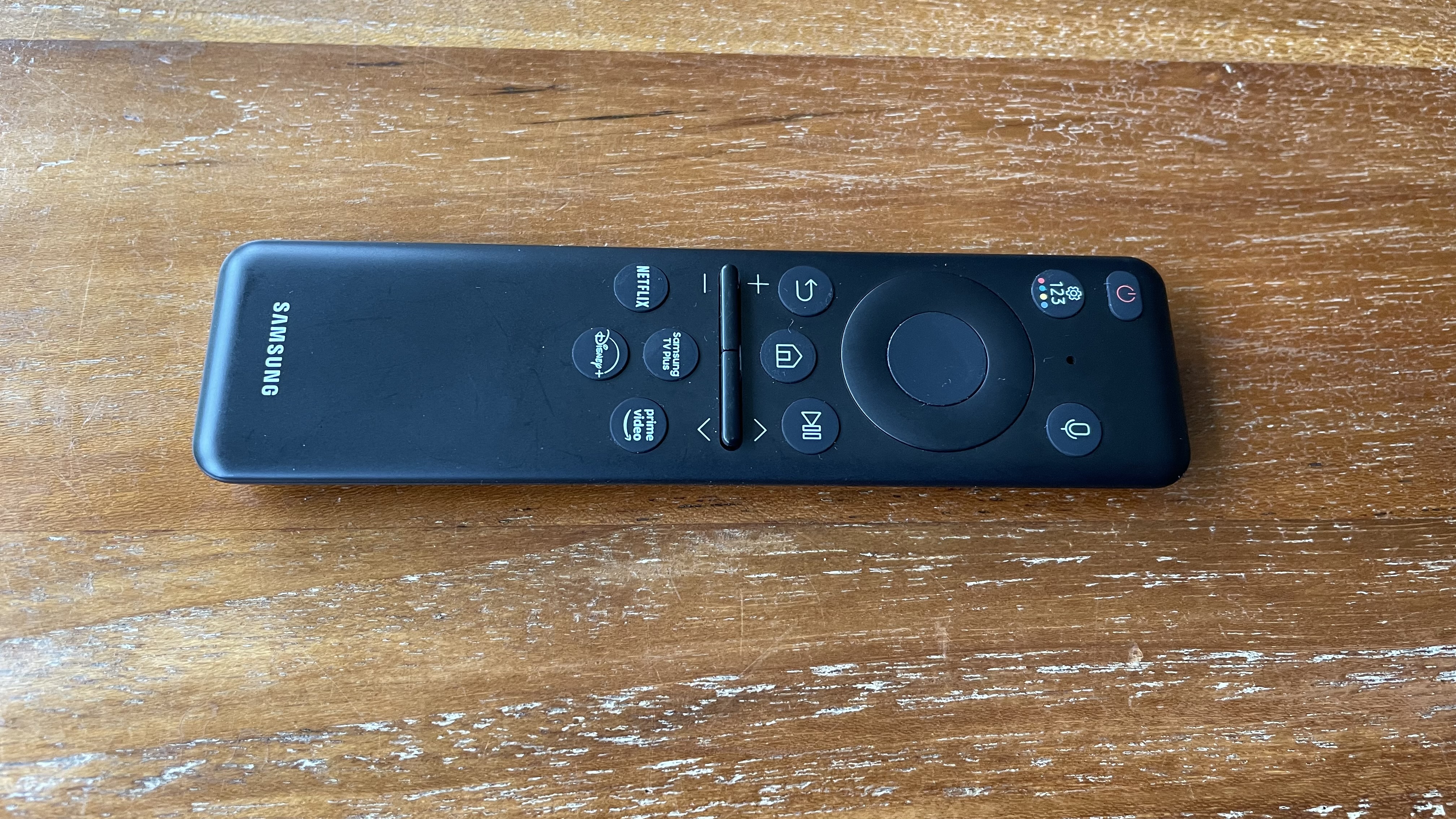
Samsung S95C OLED TV review: smart TV & menus
- Proprietary Tizen-based smart system
- Extensive voice command support
- No Freeview Play
If you’re after a comprehensive array of streaming (and much more besides) apps, the S95C covers pretty much everything most consumers could ever want. Almost every major streaming service (bar Google Play) is not only present, but delivering the very best quality it can (which typically means these days support for 4K, HDR, and Dolby Atmos sound).
The only surprising absentee (for the UK market) is Freeview Play. Crucially, though, all of the streaming services for the UK’s main terrestrial broadcasters are still provided separately; you just can’t access them under Freeview Play’s umbrella interface.
As well as all of the usual video streaming suspects, the S95C is notable for also sporting a Gaming Hub where it accumulates a currently peerless array of streamed gaming platforms, as well as providing links to the HDMI connections you’ve got recognised gaming devices attached to.
While the quantity of content the S95C carries is beyond refute, the interface it uses to present all of its options could be better. Samsung has mercifully made better choices this year over the sort of content it chooses to prioritise on the home page, and the system seems to run more consistently slickly than 2022’s debut for the new-look interface. There’s good voice recognition support too, across multiple platforms (Samsung’s own Bixby, Amazon’s Alexa and Google Assistant).
A large portion of the screen is taken up by space for advertising or pushed videos, though, which doesn’t feel very helpful, and still some of the navigation choices and routes feel long winded or illogical. The voice command system, of course, gives you a way of bypassing the menus if you really can’t get on with them.
One last little foible of the smart system is that while the S95C will play regular HDR from any service that supports it, it won’t play the premium Dolby Vision version of HDR where a service might support it. Dolby Vision streams will just play as regular HDR10.
- Smart TV & menus score: 3.5/5
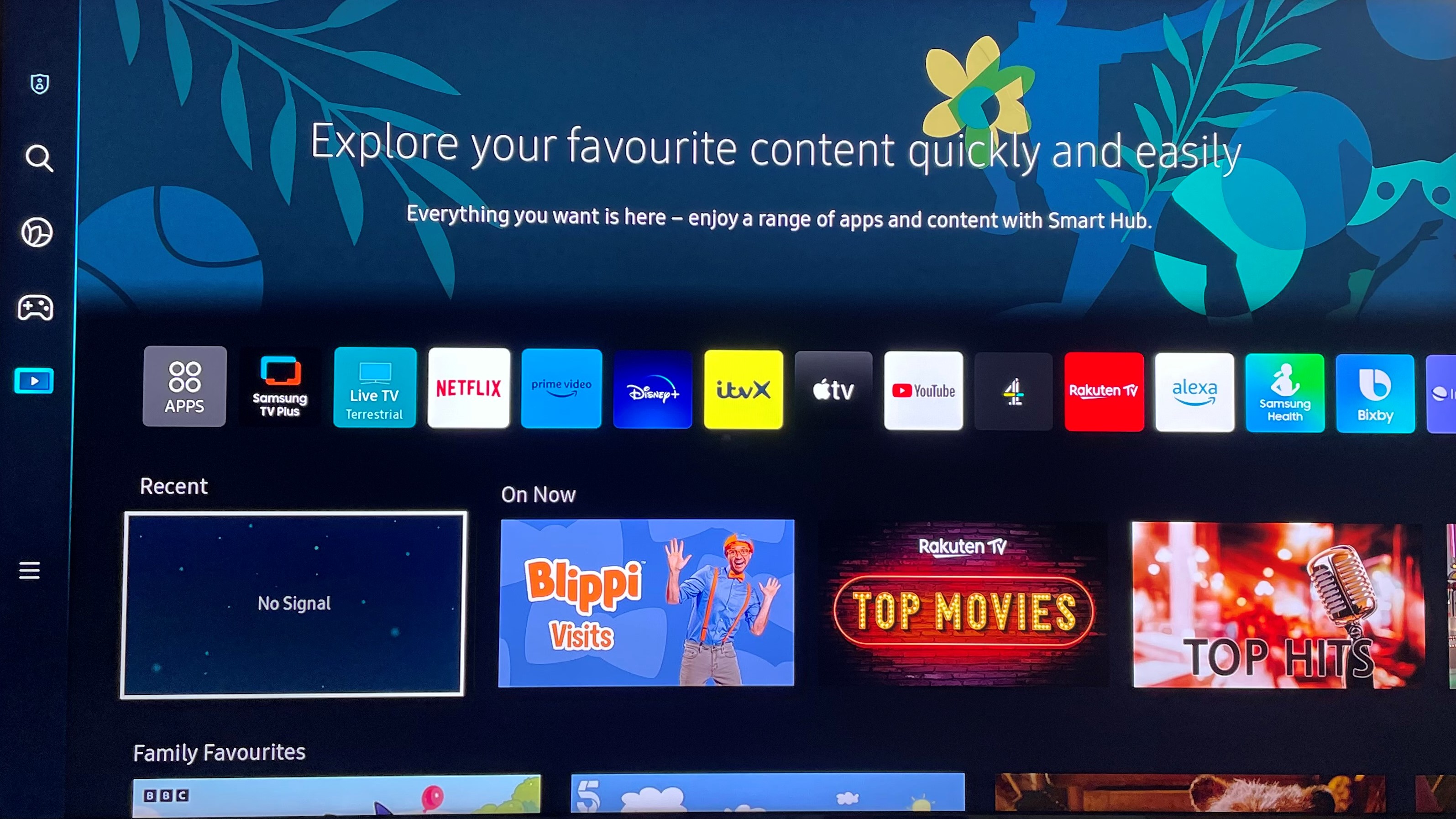
Samsung S95C OLED TV review: gaming
- Excellent gaming hub
- Extensive 4K/120Hz support
- Ultra fast 9.2ms response time
The S95C is a deliriously good gaming monitor. On the picture quality front, its new-found brightness, colour range, sharpness and detailing all prove perfect partners for the crisp, dynamic 4K HDR graphics we’re increasingly seeing on modern games, making your favourite gaming worlds even more intense and inviting places. Truly spectacular stuff.
Any slight motion issues we might have to work around with the S95C’s handling of 24 frames per second content are swiftly forgotten when you’re spinning around in Call Of Duty at a phenomenally crisp and smooth 120Hz, while the screen’s response to variable refresh rates is impeccable.
There’s support for the HGiG HDR system if you prefer it to the TV’s own HDR/HDR10+ tone mapping, as well as Auto Low Latency Mode switching, where the TV will switch automatically in and out of its fast-response Game mode depending on whether you’re playing a game or video source on your PC or console.
Samsung has also increased the number of gaming-specific features it provides this year. You can, for instance, choose to sacrifice a little response speed from the incredibly fast 9.2ms default Game mode setting in return for slightly improved visuals with games such as RPGs that might not depend on response times as much as your average shooter does.
You can call up a virtual aim point, too, and magnify and share any mini-map a game might provide. You can choose to raise the brightness of dark parts of the picture exclusively, to make it easier to find hiding enemies. The refresh rate support actually extends to 144Hz, and the set will even support the 21:9 and 32:9 ultra-wide aspect ratios available with some PC titles.
All of the S95C’s gaming features and signal information can be accessed via a simple dedicated Game Bar onscreen menu, while games can be presented with one of four genre-based graphics settings applied to them.
All of the S95C’s gaming features, finally, are available across all four of the S95C’s full bandwidth v2.1 HDMI ports, rounding off what has to be - bar the lack of any support for Dolby Vision gaming - one of the most comprehensive and spectacular gaming performances you’ll ever see from a TV.
- Gaming score: 5/5
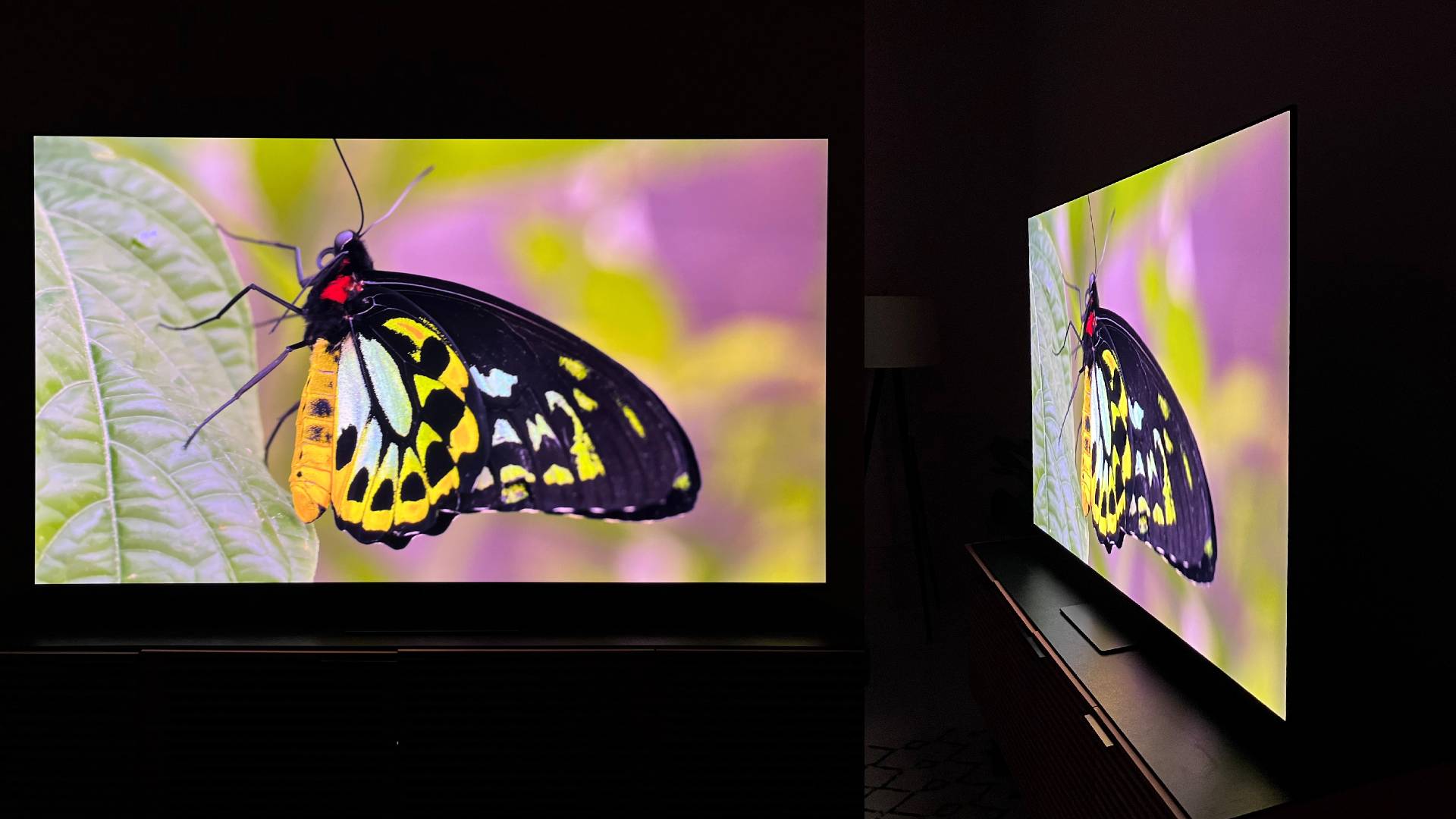
Samsung S95C OLED TV review: value
- A premium TV at a premium price
- Cheaper than Samsung’s flagship mini-LED TV
- A cheaper, less well specified QD-OLED option is available
The 65-inch S95C’s £3,599/$3,299.99 price puts it in the same price bracket as key rivals such as the 65-inch LG G3 OLED and Samsung’s own 65-inch QN95C mini-LED model. The fact that it’s slightly cheaper than the 65QN95C is interesting, as it suggests that Samsung still perceives its mini-LED technology to be its ‘best of the best’ solution. We have a feeling, though, that for many home cinema fans, at least, especially those able to darken their rooms well for movie nights, will be pretty pleased that Samsung has priced the S95C below its top mini-LED model.
The price is still high by the standards of the TV market at large, of course. But once you’ve seen what it’s capable of, it’s hard not to feel as if it’s worth every penny.
- Value score: 4/5
Should I buy the Samsung S95C OLED TV?
| Attributes | Notes | Rating |
|---|---|---|
| Features | A great mix of features to enhance both gaming and movie viewing | 5/5 |
| Picture quality | A significantly improved panel combines with outstanding processing to consistently dazzling picture quality effect | 5/5 |
| Sound quality | Although a bit more bass and forward impact would have been good, the S95C sounds much better than its predecessor and good by the standards of the TV world at large | 4/5 |
| Design | Its super-sliim profile, barely-there frame and external connections box create a suitably futuristic look | 5/5 |
| Smart TV and menus | Samsung has improved its smart system for 2023, but it’s still not very easy to follow. Fortunately the excellent voice recognition system helps a LOT | 3.5/5 |
| Gaming | The S95C carries almost every feature a cutting edge gamer could ever want, and looks consistently spectacular with graphics of all types | 5/5 |
| Value | This is a mixed bag, as the 65S95C is more expensive than most 65-inch OLED TVs, but arguably good value for such a new technology | 4/5 |
Buy it if...
You love gaming as much as movies
With its extensive gaming features and format support, the S95C is as spectacular a performer with games as it is with HDR movies.
You like a slim design/want to wall hang your TV
The S95C’s miniscule screen trim, ultra-slim rear and external connections box make it an incredibly elegant addition to any room - especially if you’re looking for a set to hang on a wall.
Don't buy it if…
Dolby Vision is a must
Samsung continues to have no truck with Dolby’s popular premium HDR format, so if you love Dolby Vision, you’re not going to love the S95C.
Mini-LED suits you more
If you have a particularly bright room to work with, even the much-improved brightness of the S95C won’t likely satisfy your TV needs on a day to day basis as much as a premium mini-LED model likely can.
Also consider...
| Samsung S95B OLED | Sony A95K OLED | Samsung QN95B QLED | |
|---|---|---|---|
| Price (65-inch): | $1,799 | $3,199 | $2,499 |
| Screen type | OLED | OLED | QLED with mini-LED |
| Refresh rate | 120Hz | 120Hz | 120Hz |
| HDR support | HDR10+, HDR10, HLG | Dolby Vision, HDR10, HLG | HDR10+, HDR10, HLG |
| Smart TV | webOS 22 | Tizen | webOS 22 |
| HDMI ports: | 4 HDMI 2.1 | 4 HDMI 2.1 | 4 HDMI 2.1 |
| Built-in tuner | ATSC 3.0 | ATSC 3.0 | ATSC 3.0 |
Samsung S95B OLED
Samsung’s debut QD OLED TV is still available at the time of writing at a knock-down price of £1,999. It falls short of the S95C’s performance in all sorts of ways, especially with its sound. But it’s still actually a strong TV overall, especially for £1,999.
Sony XR-A95K OLED
Sony also launched a QD OLED TV in 2022 in the shape of the 65A95K - and what a TV it is. It delivers more accurate and refined pictures than Samsung’s 2022 65S95B, as well as a much more powerful audio system. At £2,999, though, it hasn’t been discounted nearly as much as the Samsung 65S95B - and it isn’t nearly as bright and colourful as the new S95C.
Samsung QN95B QLED
Samsung’s 2022 mini-LED flagship is still around too, and like the 65S95B it also is now discounted to £1,999. This isn’t as good with black level, local contrast or colour as the S95C, but its extreme brightness is well suited to a bright room environment.
How I tested the Samsung S95C OLED TV
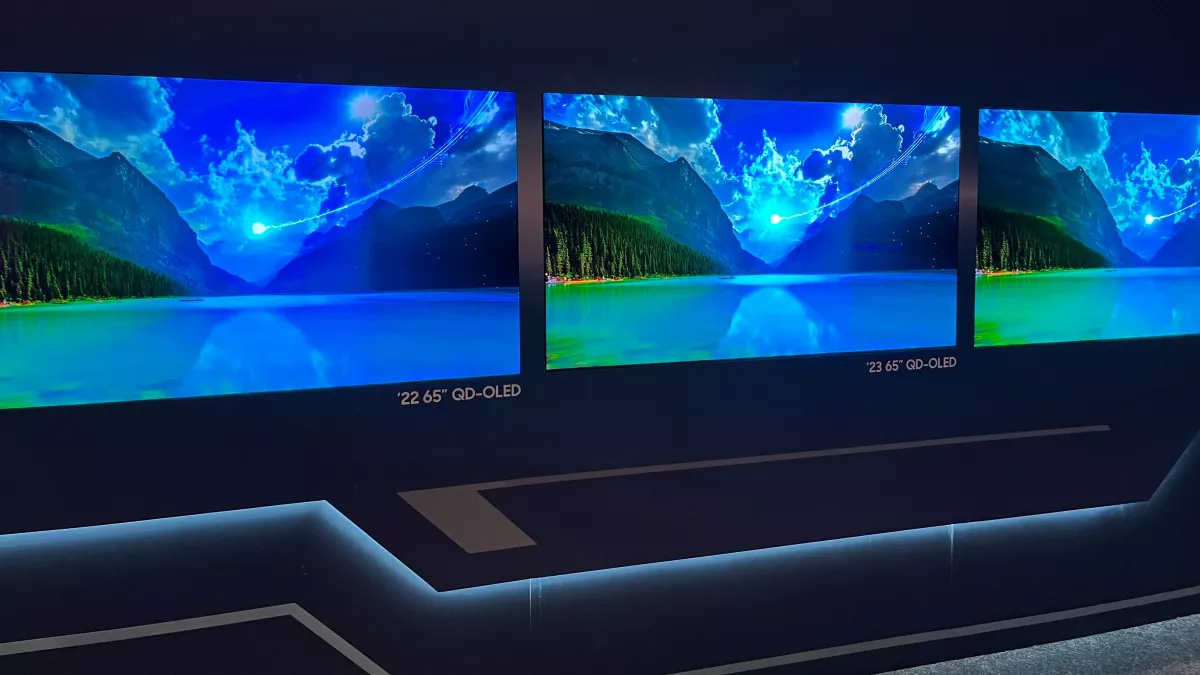
- Used test signals sourced from the Spears & Munsil Ultra HD HDR 4K Blu-ray disc
- Was evaluated side-by-side with 2022's Samsung S95B
- Brightness measurements were taken using an X-Rite i1 Display Pro light meter
The 65-inch S95C was tested in both dark test room and bright living room environments, using a mixture of familiar ‘real life’ footage and test signals sourced from the excellent Spears & Munsil Ultra HD HDR 4K Blu-ray disc. We were also fortunate enough to be able to test the 65S95C sitting directly alongside its 65S95B predecessor, using an HDFury Integral HDMI 4K splitter.
Titles that proved particularly useful for this test given our focus on assessing its star contrast and colour features were It Chapter One on 4K Blu-ray, and the recently released 4K Blu-ray of Puss In Boots, which unexpectedly features some of the brightest, most colourful images currently available on home video.
Gaming abilities were tested predominantly with a mixture of Call Of Duty Modern Warfare 2, especially in 120Hz mode, and Assassin’s Creed: Valhalla.
Brightness measurements were taken using an X-Rite i1 Display Pro light meter, while input lag was tested using a Leo Bodnar HDMI Video Signal Lag tester.
You can read much more about how we test TV at TechRadar at that link.
- First reviewed: April 2023
- Read TechRadar's reviews guarantee
John has been writing about home entertainment technology for more than two decades - an especially impressive feat considering he still claims to only be 35 years old (yeah, right). In that time he’s reviewed hundreds if not thousands of TVs, projectors and speakers, and spent frankly far too long sitting by himself in a dark room.
